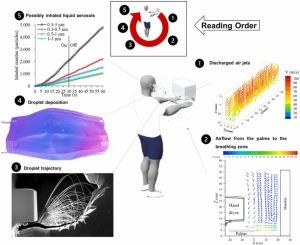在喷气式烘干机下烘干双手时产生的飞沫和气溶胶及其传播途径
IF 12.2
1区 环境科学与生态学
Q1 ENGINEERING, ENVIRONMENTAL
引用次数: 0
摘要
在使用高速喷气式烘干机烘干双手时,喷气对手部的冲击会迅速将手部皮肤上的残余水分雾化成液滴和气溶胶。液滴和液态气溶胶的排放、空间传输以及干手器使用者可能的吸入暴露等问题仍不清楚。这项研究通过粒子图像测速仪(PIV)、氦气泡轨迹分析和超声波风速仪测量了向下空气喷射式干燥机的喷射流。高速摄像机拍摄了翻手时液滴的喷发、液滴的空间运动以及液滴在人体上的沉积情况。对液体气溶胶的浓度进行了监测,并分析了气溶胶的排放总量和粒径谱。还研究了吸入排放的液体气溶胶的可能性。研究发现,大小为 0.1 至 0.6 毫米的液滴会沉积在口腔、鼻子和脸部周围。一个典型的干手过程可能会释放出大约 105 个液体气溶胶,其中 93% 为亚微米大小。如果不戴口罩烘干双手,烘手器使用者可能会吸入成千上万的液体气溶胶。本文章由计算机程序翻译,如有差异,请以英文原文为准。

Emitted droplets and aerosols and their transmission when drying hands under an air-jet dryer
When drying hands with a high-speed air jet dryer, the jet impingement on hands can quickly atomize the remnant water on the hand skins into droplets and aerosols. Emission of droplets and liquid aerosols, their spatial transport and the possible inhaling exposure to the hand dryer user remain unclear. This investigation measured the jet flows from a downward air jet dryer, by the particle image velocimetry (PIV), the helium bubble trajectory analysis, and an ultrasonic anemometer. Emission of the droplets when turning over the hands, the droplet spatial motion, and their deposition on human body were photographed by a high speed camera. Concentrations of the liquid aerosols were monitored and the total emitted aerosol numbers and size spectrum were analyzed. The possible inhalation exposure to the emitted liquid aerosols was examined. It is found that number of droplets in size of 0.1 to 0.6 mm can deposit on the mouth and nose and the surrounding face. A typical hand drying process may emit approximately 105 liquid aerosols, of which 93 % are in the submicron size. A hand dryer user may inhale thousands of the emitted liquid aerosols if drying hands without wearing face mask.
求助全文
通过发布文献求助,成功后即可免费获取论文全文。
去求助
来源期刊

Journal of Hazardous Materials
工程技术-工程:环境
CiteScore
25.40
自引率
5.90%
发文量
3059
审稿时长
58 days
期刊介绍:
The Journal of Hazardous Materials serves as a global platform for promoting cutting-edge research in the field of Environmental Science and Engineering. Our publication features a wide range of articles, including full-length research papers, review articles, and perspectives, with the aim of enhancing our understanding of the dangers and risks associated with various materials concerning public health and the environment. It is important to note that the term "environmental contaminants" refers specifically to substances that pose hazardous effects through contamination, while excluding those that do not have such impacts on the environment or human health. Moreover, we emphasize the distinction between wastes and hazardous materials in order to provide further clarity on the scope of the journal. We have a keen interest in exploring specific compounds and microbial agents that have adverse effects on the environment.
 求助内容:
求助内容: 应助结果提醒方式:
应助结果提醒方式:


